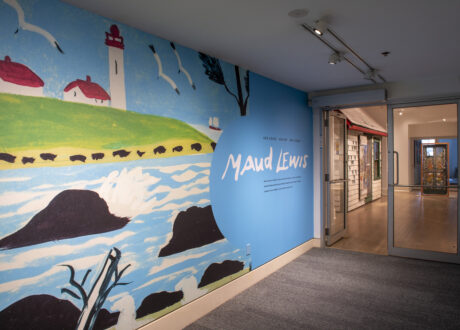

The Mi’kma’ki Artists’ Spotlight, a section found within the exhibition Ta’n a’sikatikl sipu’l | Confluence, celebrates artwork created by Indigenous artists across Mi’kma’ki (the territory of the Mi’kmaq Nation).
Mi’kmaq Territory stretches across Newfoundland, Nova Scotia, parts of New Brunswick, Prince Edward Island, the Gaspé Peninsula of Quebec, and Northeastern Maine. The Mi’kma’ki Artists’ Spotlight is designed to be refreshed and rejuvenated regularly with newly featured artists.
In 2024 – 2025, we are delighted to host Mi’kmaw porcupine quillwork by the Quill Sisters artist trio: Kay Sark, Cheryl Simon, and Melissa Peter-Paul!
For the past century, porcupine quillwork practices were largely sleeping on Mi’kma’ki. The Quill Sisters have collaborated for several years to rekindle this art form while igniting discussions on treaty rights, climate change, sustainability, and reciprocity. This collection offers multiple entry points to engage with quillwork. Each artist takes on traditional approaches using birchbark embellishment techniques, while expanding mediums with conceptual connections to this contemporary and historical practice.

From left to right:
Cheryl Simon, Sasap, 2024.
Kay Sark, Cosmo and Wanda, 2024.
Melissa Peter-Paul, Trip Down to Maine, 2024.
About the Artists

Kayla Sark is a Mi’kmaq woman from Lennox Island, Epekwit (PEI). Kay was accepted as an apprentice to Mi’kmaq Quill Art in 2016 and learned the traditional harvesting practices and quilling techniques. She went on to share the artform with her children and then with the broader community through instructing workshops for over five years. .
Kay and her partner share in harvesting porcupine quills, sweet grass and birch bark, making her quill art a launching point for a shared cultural experience for her family. Once she learned the basic technique, Kay quickly developed a unique style drawing upon personal inspiration rather than being influenced by more traditional designs.
Kay enjoys the creative process which is inspired by different colour combinations. She begins each piece by quilling a foundational star, then incorporates the colour combinations to bring balance and unique detail to the work. Kay gravitates to the eight-pointed star and feels a connection to that particular design as it has become such a symbolic representation of the Mi’kmaq nation.

Cheryl Simon is a Mi’kmaq e’pit (woman) from Epekwitk (PEI), currently residing in Halifax, who works with porcupine quills, birchbark, spruce root and sweetgrass.
Cheryl fell in love with Mi’kmaq quillwork as a little girl studying her mother’s collection of quill boxes. She started learning and studying the insertion technique and design upon moving back to Mi’kma’ki in 2007, and launched her business, Mi’kmaq Quill Art in 2011. Cheryl is committed to community education of the art form and has been teaching quillwork workshops for over ten years. She took on her first apprentice in 2015 and opened a short-term studio in Epekwitk in 2016 to begin a program of instruction for three more apprentices.
While Cheryl focuses on traditional quillwork and construction, she also developed a process for accurately depicting the petroglyphs (rock carvings) after visiting the petroglyph sites in Nova Scotia. Over the past two years, she decided to incorporate both traditional designs and the petroglyph technique into the same quillwork pieces. This blending of styles lets her showcase the importance quill size can make in enhancing the detail of the design.
Cheryl was recently inspired by contemporary Mi’kmaq art to move beyond the quill box lids, which influenced her early work to split the design into separate pieces, adding a vibrancy to the designs. She has taught her children to harvest and quill and is excited to begin the process of teaching them the intricacies of designing in the traditional style. She feels that quillwork requires strong connections and is proud that the community of quillers is expanding to include the younger generations.

Melissa is a Mi’kmaw woman from Abegweit First Nation, located on Epekwitk (PEI). Growing up, Melissa was immersed in cultural teachings and was surrounded by a family of basket makers.
Melissa began her artistic expression at a young age, making regalia and beadwork, and is skilled in both traditional and contemporary styles. Her exposure to other Mi’kmaq artforms led her to quillwork, a traditional skill in which the ancestors of her maternal grandfather excelled.
Melissa was accepted into an apprenticeship with Mi’kmaq Quill Art in 2015. Her training was grounded in the traditional insertion technique and utilized the study of both cultural teachings and formal material culture resources that were available through historic publications and museums.
Quillwork is created by inserting porcupine quills, either dyed or kept natural, into birchbark. The pieces are then edged with quills, sweetgrass or spruce root. Over the course of her apprenticeship, Melissa learned techniques and protocols related to harvesting raw materials, as well as the complex geometry of traditional design work. Upon completion of her apprenticeship, Melissa has been integral in establishing a community of skilled quill workers. This community of quillers seeks to expand awareness of the artform and recently began working on collaborative projects.
Melissa launched her professional career as a Mi’kmaq quill artist with her first solo exhibit at Receiver Coffee presented by This Town is Small in Charlottetown in 2019. She is heavily influenced by 20th century Mi’kmaw quillwork, and she is supported in her harvesting efforts by her family. Melissa is proud to be passing the art on to her two sons and the broader community.
Image: Brady McCloskey



